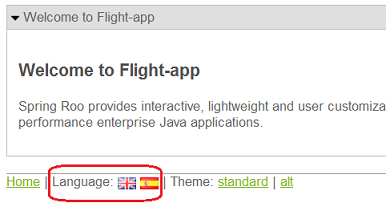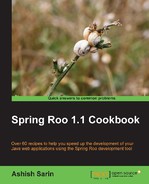Roo supports internationalization of the complete UI by using resource bundles for labels and messages. In this recipe, we will look at the web mvc install language command of Roo and see how it simplifies internationalizing the Roo-generated web user interface.
Delete the contents of ch04-recipe sub-directory inside the C:
oo-cookbook directory.
Copy the ch04_web-app.roo script into the ch04-recipe directory.
Execute the ch04_web-app.roo script that creates the flight-app Roo project, sets up Hibernate as the persistence provider, configures MySQL as the database for the application, creates the Flight and FlightDescription JPA entities and defines a many-to-one relationship between the Flight and FlightDescription entities. If you are using a different database than MySQL or your connection settings are different than what is specified in the script, then modify the script accordingly.
Start the Roo shell from the C:
oo-cookbookch04-recipe directory.
Execute the controller all command to create controllers and views corresponding to the JPA entities in the flight-app project, as shown here:
.. roo> controller all --package ~.web
Execute the perform eclipse command to update the project's classpath settings, as shown here:
.. roo> perform eclipse
Now, import the project into your Eclipse IDE.
For internationalizing the Roo-generated web user interface execute web mvc install language, as shown here:
.. roo> web mvc install language --code es Created SRC_MAIN_WEBAPPWEB-INFi18nmessages_es.properties Created SRC_MAIN_WEBAPPimageses.png Managed SRC_MAIN_WEBAPPWEB-INFviewsfooter.jspx
The web mvc install language command accepts a single argument: code, which identifies the language code for which the support needs to be added to the web application. The code argument accepts a pre-defined language code, depending upon the languages supported by Spring Roo. Spring Roo contains translations for the standard messages and labels for the following language codes: de (German), en (English), es (Espanol), it (Italian), nl (Dutch), and sv (Swedish).
When the web mvc install language command is executed, Roo processes the command by taking the following actions:
- Creates the
messages_es.propertiesin/WEB-INF/i18n/folder - Copies an image icon (
es.png) for the language in theimagesdirectory - Updates
/WEB-INF/views/footer.jspxto show the image icon for the language
To check if the support for the Espanol language is correctly installed, deploy and run the flight-app application. The following screenshot shows the home page of the flight-app application, after the Espanol language support is added:

As the given screenshot shows, an additional image icon is displayed to allow users to change the language of the web application to Espanol. When a user clicks the image icon corresponding to a language, the lang request parameter is set in the request, which is used by LocaleChangeInterceptor (configured in the /WEB-INF/spring/webmvc-config.xml) for changing the current locale.
The CookieLocaleResolver
configured in the /WEB-INF/spring/webmvc-config.xml stores a cookie named locale in the browser, so that users don't need to change their preferred language every time they access the web application.
In the Auto-generating Spring MVC controllers and the JSPX views from the JPA entities recipe, we discussed that the messages.properties contains messages and labels that are common to all Roo-generated web applications and the application.properties contains application-specific messages and labels.
As Roo can't provide translations for application-specific messages and labels, the web mvc install language command doesn't create an application_<language-code>.properties file. It is left up to the developer to create an application_<language-code>.properties file for specific language codes and provide translations.
